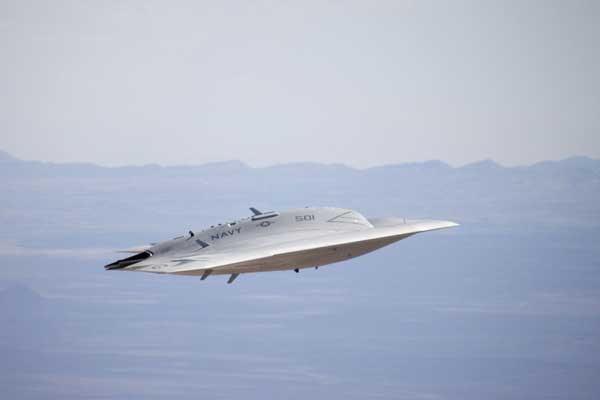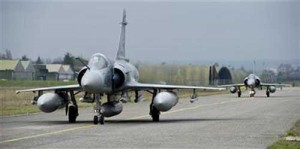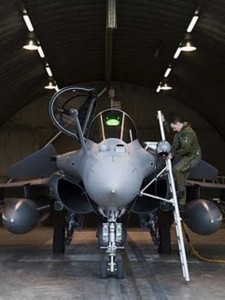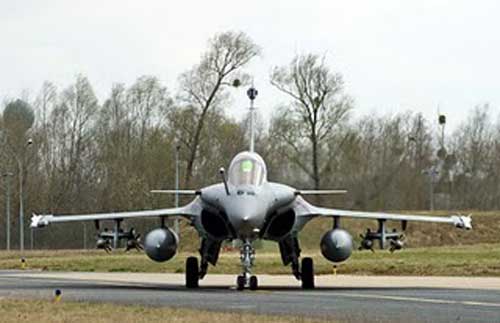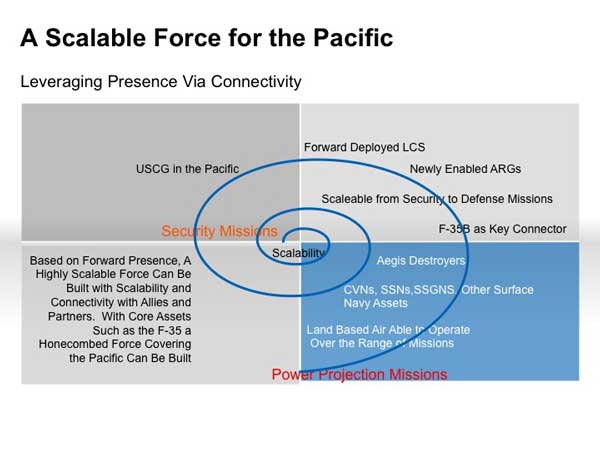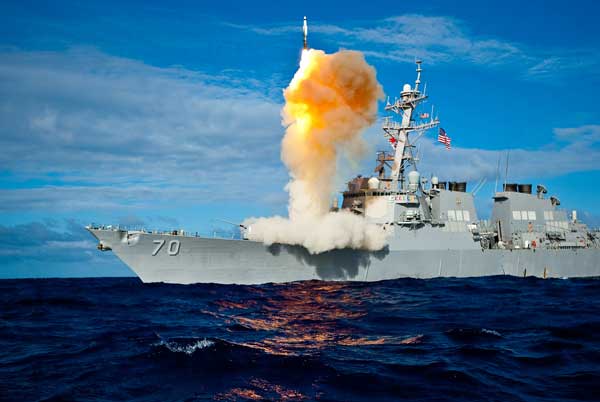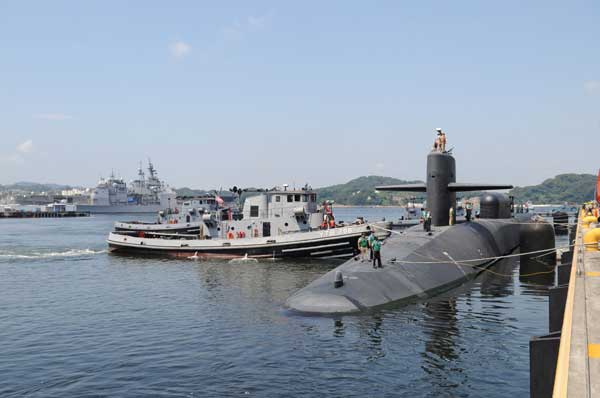10/27/2011 – by Ed Timperlake
Ever since the evacuation of the Chinese Nationalist Forces to Taiwan after their defeat on the mainland by Mao’s Peoples Liberation Army (PLA) the Peoples Republic of China (PRC) has quested for a complete victory by establishing sovereignty over that island fortress.
Taiwan is an island 89 miles across and 245 miles long, and approximately the same distance from mainland China as the US island of Key West is from Cuba. Taiwan is 99 miles from the mainland and Key West is 94 from Cuba.
The post WW II history of the Peoples Republic of China (PRC) vs. the Republic of China (ROC) has been an on again off again quasi hot war. PLA shelling of the much closer ROC Islands of Quemoy and Matsu, was a real flash point in Cold War brinkmanship
It got so contentious that in 1954 the use of nukes against mainland China was advocated by the JCS but was resisted by Ike. Instead treaty commitments were made for defense of the Island in the event of an attack.
Consequently, the flash point of ensuring the survivability of a free democracy of 23 million Chinese in the Republic of China moved to US deterrence by Navy Carrier Battle Groups in the nineties. The PRC livid on so many levels about the ROC returned the 1954 US JCS recommendation about using nukes in a very public way. A PLA general said to an American diplomat as a CBG was showing presence in the Taiwan Straights– is the US prepared to trade Taipei for L.A?
The practical issue below nuke bluster is that the real battle for Taiwan has always been looked at in conventional terms.
It is very fair to say after the Clinton administration executed an effective, and insulting to PRC, show of force with USN Carrier Battle Groups in the nineties one of the principal raison d’etats of PLA military forces (PLA.PLAAF, PLAN and 2nd Artillery, Special Forces and seaborne infantry) is to modernize and train to conquer ROC by force.
Being smart the PRC has two additional strategies. One makes enough bluster so that the ROC surrenders peacefully into reunification, or, two essentially buy them so the Taiwan Democracy votes for unification.
However, if the PRC makes a military move a well designed and executed Air/Sea/Land Battle US battle plan leveraging presence, scalability and multiple access can make such an attack become the PLA’s equivalent of the US WWII Battle of the Bulge.
The U.S. goal if the PLA goes “feet wet” to cross the Straight, if we continue to build out our current technology in sufficient numbers, will be to make all their strike forces and their entire surface fleet die.
This boldness can be grasped with U.S. emerging military strategy of “‘No platform fight alone and make a Mao legacy centric force fight individually in the dark and die.” This strategic and tactical mindset will have the same effect the Bulge had on the German Forces as General Patton said: “Hell let’s have the guts to let those son-of-a-bitches go all the way to Paris. Then we’ll cut ‘em off and chew ‘em up.”
It will just take the fighting Navy/Marine/AF team with allied assistance to really “chew ‘em up”.
Unfortunately, the ‘Thinking Navy” isn’t.
In a July 11, 2011 story about the improving military capability of the Peoples Republic of China—“China’s ‘eye in the sky’ nears par with US” —A professor at the US Naval War College symbolically rowed ashore and surrendered her sword to the PLA forces.
Another cubicle commander articulates the way ahead.
“The United States has always felt that if there was a crisis in Taiwan, we could get our naval forces there before China could act and before they would know we were there. This basically takes that off the table,” said Joan Johnson-Freese, a professor at the US Naval War College in Rhode Island.
History shows the fighting Navy/Marine/AF team with modern 21st Century weapons and systems might think and prove otherwise.
Rick Fisher, a Senior Fellow on Asian Military Affairs at the International Assessment and Strategy Center, nails it on the need for strong capable 21st century technology in the Pacific to deter war.
Washington gains nothing by delaying the sale of new F-16s to Taiwan. Selling new F-16s with modern subsystems will more quickly prepare the Taiwan Air Force for what it really needs, a version of the fifth-generation F-35. Depending upon the equipment package, upgrading Taiwan’s early model F-16s can sustain a low level of parity, but that will not keep pace with a Chinese threat that grows every day.
The statement in a global newspaper from the Naval War College by Professor Johnson-Freese sends the exact opposite signal.
First a history lesson for Professor Johnson-Freese.
Less then a year after the attack on Pearl Harbor, the “Doolittle Raiders” had their “30 Seconds Over Tokyo” bombing raid. In doing so the Navy-Army Air Corp team gave the Japanese leaders a real wake up call that they would ultimately lose WWII. B-25 Army Air Force crews made their heroic flight launching from the deck of the CV-8, USS Hornet.
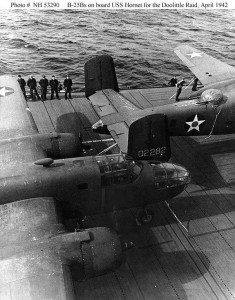
After the Doolittle Raid, the USS Hornet continued to fight the Imperial Japanese Fleet. At the Battle Of Midway the entire complement, save one pilot, of Torpedo Squadron 8 from the Hornet were all killed, but the great miracle at Midway victory was achieved.
Finally, the heroic ship was sunk at the Battle of the Santa Cruz Island. Quoting various reports about the battle proved that it was a hard ship to kill.
From various sources compiled by Wikipedia:
- In a 15-minute period, Hornet took three bomb hits from “Val” dive bombers, another bomb hit compounded by the “Val” itself crashing into the deck, two torpedo hits from “Kates”, and another “Val” crashing into the deck. Because of the damage the Hornet was taken undertow when another Japanese plane scored a hit.
- The order was given to abandon ship. U.S. forces then attempted to scuttle Hornet, which absorbed nine torpedoes and more than 400 5 in (130 mm) rounds from the destroyers Mustin and Anderson. Mustin and Anderson moved off when a Japanese surface force appeared in the area.
- Japanese destroyers Makigumo and Akigumo then finished Hornet with four torpedoes. At 01:35 on 27 October, she finally sank with the loss of 140 of her crew
- It was the last US fleet Carrier to be sunk in WW II.
And another history lesson this time from a class in naval history over four decades ago at the US Naval Academy. I have tried to find the original source but just remember the professor’s narrative.
As the war in the Pacific got closer to the main Islands of Japan, Kamikaze – the “unmanned” vehicles of the day — were used to attack the American battle fleet—at that time the aircraft carrier was the primary ship leading the attack. So killing carriers was the goal. The Navy knowing this screened the fleet carriers with radar picket Destroyers to both give warning and provide anti-aircraft fire at incoming Kamikazes.
During a lull in after a wave of deadly Kamikaze attacks a voice was heard skipping across the waves-by sailors of the main fleet — sound can do this at sea. As told it was an ensign on a radar picket ship and he was telling the crew that all the officers were killed but he was in command and they would continue to fight the ship—the Destroyer was lost.
There is a fundamental rule in tactical battles that all technology is relative against a reactive enemy. With that said, it is most often the intangibles of training, tactics, and quickly reacting to develop newer and more capable technology that can win the final battle.
Now to the 21st Century–apparently the professor missed a recent event.
If PLA satellites are a problem and it is a choice between putting a carrier battle group at risk or fighting a space war, I think the fighting Navy is capable and ultimately ruthless enough to blind the PRC military.
After the PLA shot down a satellite from a land based launch pad the US Navy demonstrated our at sea capability – from a Department of Defense report:
“At approximately 10:26 p.m. EST, Feb. 20, (2008) a U.S. Navy AEGIS warship, USS Lake Erie (CG-70), fired a single modified tactical Standard Missile-3 (SM-3) hitting the satellite approximately 133 nautical miles over the Pacific Ocean as it traveled in space at more than 17,000 mph. USS Decatur (DDG-73) and USS Russell (DDG-59) were also part of the task force.”
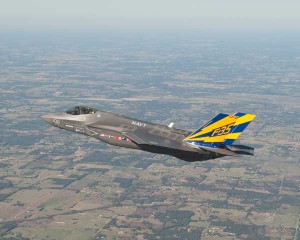
So to make it simple for the PLA, PLAN. PLAAF and 2nd Artillery: the US Navy, Air Force and Marine Corps are battle tested, currently with ten years of real, but different, combat experience. When provoked the US has a legacy of carrying the fight to any enemy.
But wait, Professor, it gets even better.
In the 21st century it will be important that no platform fight alone. USN satellite killing Aegis ships will soon be joined by F-35s flying from the Navy/Marine Amphibious Readiness Group “Gator” Navy-the USMC F-35B V/Stol. This is a huge at sea multiplier in capability.
Carrier Battle Group Air Wings with the F-35C will give Naval Forces afloat both situational awareness and the ability to fight a 3 Dimensional War. Add in attack subs and SSGN’s with cruise missiles and a hidden US vigilant on station offense punch remains silent but deadly.
Finally, like the radar picket ships of WWII, current Destroyers, frigates and perhaps even the Littoral Combat Ship (LCS) can add a huge defensive element against CHICOM incoming missiles. The capability to spoof and jam incoming guided weapons is an art of “tron” war practiced by Navy forces for decades. One can imagine the targeting frustration trying to hit a 50+ knot LCS that an incoming warhead thinks is an aircraft carrier.
It gets even better, by pure accident during a test flight over Pax River an F-35 system picked up a launch in Florida over 800 miles away. So the second a missile is launched against the fleet the Commander can light up the launch pad using a combination of B-2s and F-22s, especially in a their emerging Suppression of Enemy Air Defensive (SEAD) role along with at sea and sub launched cruise missiles.
Eventually UAS systems with combat firepower guided by F-35s and the robot revolution can take out any threat, launch be seen and die. This F-35 ability has been further validated in the exercise “Northern Edge.” It was reported one F-35 capable test bed aircraft using F-35 current sensor/radar systems could sweep over 50,000 square miles of ocean.
So rather then unilaterally as suggested in print “take our forces off the table,” the 21st century Navy can blind them and blast them-and that is real deterrence and should give the PRC pause before starting a hostile action.
American just needs the political will to continue to commit the resources to keep the US Navy/Marine/AF the number one fighting force in the Pacific.
A USMC General David Shoup, the Commandant pointed out how hard crossing 94 miles of Ocean can be to invade an Island. Commandant Shoup, Congressional Medal of Honor, for action on Tarawa pointed out the relative size of Tarawa to Cuba when a lot of bluster was being raised about invading Cuba. He took a map of Cuba and then put a dot on the map. When some asked what was that he said “That Gentlemen is the island of Tarawa it took us three days and eighteen thousand Marines to take it”
(Taken from David Halberstam’s great book “The Best and the Brightest”).






